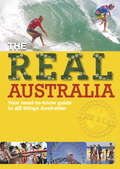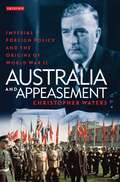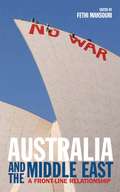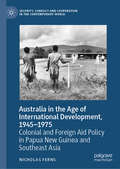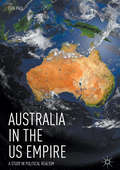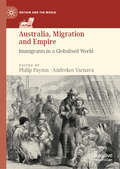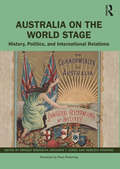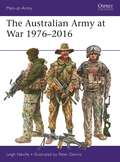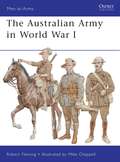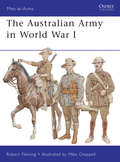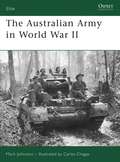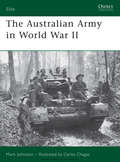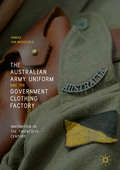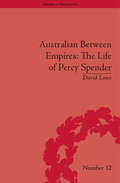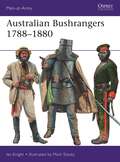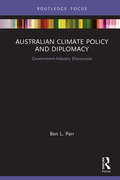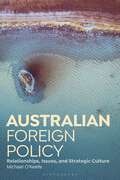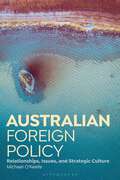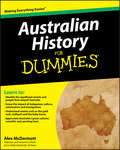- Table View
- List View
Australia (The Real #7)
by Kim O'donnellIs there somewhere you really want to travel to, or just yearn to know better?Do you want all the essential facts about Australia at your fingertips?If you want to know what it's really about (rather than the things your parents think you should see!), The Real Australia is a great place to start.• What's hot: Australia highlights you really won't want to miss• Get a taste for Australia's amazing food scene, from beach barbecues to top chefs• Tantalising accounts of the best sights• Maps and photos that put you into the action• The best of Australian food, music, festivals and sport• Key information for travellers to AustraliaWhether you are planning a trip or a holiday, just day-dreaming about one or simply need to know the facts, The Real Australia is your essential guide.
Australia and Appeasement: Imperial Foreign Policy and the Origins of World War II (International Library of Twentieth Century History)
by Christopher WatersOn 3 September 1939, Robert Menzies, the Australian Prime Minister, broadcast to the Australian people the news that their country was at war with Germany. He went on to outline how Britain and France, supported by the British Dominions, had made every effort to maintain the peace by keeping the door open to a negotiated settlement. However, as these efforts had failed, Menzies declared that the British Empire was now 'involved in a struggle which we must at all costs win, and which we believe in our hearts we will win'.Christopher Waters here examines Australia's role in Britain's policy of appeasement from the time Hitler came to power in 1933 through to the declaration of war in September 1939. Focusing on the five leading figures in the Australian governments of the 1930s - Joe Lyons, Stanley Bruce, Robert Menzies, Billy Hughes and Richard Casey - Waters examines their responses to the rise of Hitler and the growing threat of fascism in Europe. Australian governments accepted the principle that the Empire must speak with one voice on foreign policy and Australian political leaders were therefore intimately involved in the decisions taken by successive governments in London. As such, this book not only describes the Australian role in these events, but also provides new insights into the Chamberlain government's reactions to the developments in Europe. Australia and Appeasement provides an important and original study of the making of imperial foreign policy in the inter-war era and will be invaluable reading for anyone interested in Australian and imperial history and the origins of World War II.
Australia and the Middle East: A Front-line Relationship (Library of International Relations)
by Fethi MansouriWhat is the history behind Australia's relations with the Muslim world, and the Middle East in particular, which led Australia to be described as a frontline of the so-called 'War on Terror'? Australia's encounters with the Middle East have historically been defined through the British Empire, the Commonwealth and, more recently, through its close strategic ties with the US. This book traces the nature of the Australia-Middle East relationship, from an insular 'White Australia' ideology through to the ongoing global impact of September 11 and the decision to send troops to Iraq and Afghanistan. Comprehensive analysis of these complex ties provides an essential basis for understanding past encounters, evaluating present policies and developing a framework for future interactions. Australia and the Middle East draws together the various dimensions and themes of this relationship – from trade and migration, to increasing strategic interest and military involvement in the region.
Australia in the Age of International Development, 1945–1975: Colonial and Foreign Aid Policy in Papua New Guinea and Southeast Asia (Security, Conflict and Cooperation in the Contemporary World)
by Nicholas FernsThis book examines Australian colonial and foreign aid policy towards Papua New Guinea and Southeast Asia in the age of international development (1945–1975). During this period, the academic and political understandings of development consolidated and informed Australian attempts to provide economic assistance to the poorer regions to its north. Development was central to the Australian colonial administration of PNG, as well as its Colombo Plan aid in Asia. In addition to examining Australia’s perception of international development, this book also demonstrates how these debates and policies informed Australia’s understanding of its own development. This manifested itself most clearly in Australia’s behavior at the 1964 United Nations Conference on Trade and Development (UNCTAD). The book concludes with a discussion of development and Australian foreign aid in the decade leading up to Papua New Guinea’s independence, achieved in 1975.
Australia in the US Empire: Australia In The Us Empire
by Erik PaulThis book argues that Australia is vital to the US imperial project for global hegemony in the struggle among great powers, and why Australia's deep dependency on the US is incompatible with democracy and the security of the country. The Australian continent is increasingly a contestable geopolitical asset for the US grand strategy and for China's economic and political expansionism. The election of Donald Trump to the US presidency is symptomatic of the US hegemonic crisis. The US is Australia's dangerous ally and the US crisis is a call for Australia to regain sovereignty and sever its military alliance with the US. Political realism provides a critical paradigm to analyse the interactions between capitalism, imperialism and militarism as they undermine Australian democracy and shift governmentality towards new forms of authoritarianism.
Australia & Israel: A Diasporic, Cultural and Political Relationship
by Burla, Shahar; Lawrence, DashielAustralia and the State of Israel have maintained a cordial if at times ambiguous relationship. The two countries are geographically isolated: strategic, economic and cultural interests lie increasingly with Asia for one, and with the US and the EU for the other. But for all that divides the two states, there is also much they share. Australia played an important role in the Jewish state's establishment in 1948, and is home to the most Zionist centered Jewish diaspora globally. Jewishness for most Australian Jews has been shaped and defined by engagement with and support for Israel. At the heart of this engagement is a small but thriving Israeli community within the larger multicultural Australia. Australia and Israel: A Diasporic, Cultural and Political relationship draws attention to the important historical and contemporary nexus between this diaspora and its imagined homeland. The collection also considers the ways in which these two states mobilise national myths and share environmental challenges. In recent time relations between the two states have been tested by the illegal use of Australian passports in 2010, the mysterious death of dual national Ben Zygier, and growing disquiet within the ranks of the Australian Labor Party and the Australian Greens over Israel's handling of the Israel-Palestinian conflict. One prominent world-wide issue is the Palestinian BDS (Boycotts, Divestments and Sanctions) movement, which has attracted sympathy and support that has brought about substantive differences of opinion regarding its legitimacy within the Jewish Australian community. These issues demonstrate the multifaceted and complex picture of two very different nations, that nevertheless share an abiding connection.
Australia, Migration and Empire: Immigrants in a Globalised World (Britain and the World)
by Philip Payton Andrekos VarnavaThis edited collection explores how migrants played a major role in the creation and settlement of the British Empire, by focusing on a series of Australian case studies. Despite their shared experiences of migration and settlement, migrants nonetheless often exhibited distinctive cultural identities, which could be deployed for advantage. Migration established global mobility as a defining feature of the Empire. Ethnicity, class and gender were often powerful determinants of migrant attitudes and behaviour. This volume addresses these considerations, illuminating the complexity and diversity of the British Empire’s global immigration story. Since 1788, the propensity of the populations of Britain and Ireland to immigrate to Australia varied widely, but what this volume highlights is their remarkable diversity in character and impact. The book also presents the opportunities that existed for other immigrant groups to demonstrate their loyalty as members of the (white) Australian community, along with notable exceptions which demonstrated the limits of this inclusivity.
Australia on the World Stage: History, Politics, and International Relations
by Bridget Brooklyn Benjamin T. Jones Rebecca StratingAustralia on the World Stage: History, Politics, and International Relations offers a fresh examination of Australia’s past and present. From the complex interactions of First Nations to modern international relations with significant partners and allies, it examines the forces that have influenced the place now called Australia both historically and today. It is a unique history told in two parts. The first half of the book examines the way Australia acted on the world stage both before and after British colonisation. It outlines the evolution of Australia’s relationship with the United Kingdom, first as colonies, then a dominion, and finally as an independent nation. It finishes with a First Nations perspective on foreign relations. The second half of the book provides a wide-ranging history of Australia’s dealings with major powers, the United States and China, as well as its relationships with New Zealand, Aotearoa, the Pacific Islands, Indonesia, Japan, Antarctica, and the United Nations. Written by leading and emerging researchers in their fields, this book encourages the reader to consider Australia’s performance on the world stage over the longue durée, well before the word ‘Australia’ was ever dreamt up. This interdisciplinary work challenges lazy stereotypes that see Australia's international history as fixed and uncontested. In revisiting Australia’s foreign relations, this work also asks the reader to consider its future directions.
Australia on the World Stage: History, Politics, and International Relations
by Bridget Brooklyn Benjamin T. Jones Rebecca StratingAustralia on the World Stage: History, Politics, and International Relations offers a fresh examination of Australia’s past and present. From the complex interactions of First Nations to modern international relations with significant partners and allies, it examines the forces that have influenced the place now called Australia both historically and today. It is a unique history told in two parts. The first half of the book examines the way Australia acted on the world stage both before and after British colonisation. It outlines the evolution of Australia’s relationship with the United Kingdom, first as colonies, then a dominion, and finally as an independent nation. It finishes with a First Nations perspective on foreign relations. The second half of the book provides a wide-ranging history of Australia’s dealings with major powers, the United States and China, as well as its relationships with New Zealand, Aotearoa, the Pacific Islands, Indonesia, Japan, Antarctica, and the United Nations. Written by leading and emerging researchers in their fields, this book encourages the reader to consider Australia’s performance on the world stage over the longue durée, well before the word ‘Australia’ was ever dreamt up. This interdisciplinary work challenges lazy stereotypes that see Australia's international history as fixed and uncontested. In revisiting Australia’s foreign relations, this work also asks the reader to consider its future directions.
The Australian Army at War 1976–2016 (Men-at-Arms)
by Leigh NevilleSince the end of their involvement in the Vietnam War, the Australian Army has been modernized in every respect. After peacekeeping duties in South-East Asia, Africa and the Middle East in the 1980s–90s, 'Diggers' were sent to safeguard the newly independent East Timor from Indonesian harassment in 1999, and to provide long-term protection and mentoring since 2006. Australian Army units have served in the US-led wars in Iraq and Afghanistan, and Australian Special Forces are currently operating alongside US and British elements against ISIS in northern Iraq. During these campaigns the Australian SAS Regiment and Commandos have fully matured into 'Tier 1' assets, internationally recognized for their wide range of capabilities. The book, written by an Australian author who has written extensively about modern warfare, traces the development of the Army's organization, combat uniforms, load-bearing equipment, small arms and major weapon systems using specially commissioned artwork and photographs.
The Australian Army at War 1976–2016 (Men-at-Arms #526)
by Leigh NevilleSince the end of their involvement in the Vietnam War, the Australian Army has been modernized in every respect. After peacekeeping duties in South-East Asia, Africa and the Middle East in the 1980s–90s, 'Diggers' were sent to safeguard the newly independent East Timor from Indonesian harassment in 1999, and to provide long-term protection and mentoring since 2006. Australian Army units have served in the US-led wars in Iraq and Afghanistan, and Australian Special Forces are currently operating alongside US and British elements against ISIS in northern Iraq. During these campaigns the Australian SAS Regiment and Commandos have fully matured into 'Tier 1' assets, internationally recognized for their wide range of capabilities. The book, written by an Australian author who has written extensively about modern warfare, traces the development of the Army's organization, combat uniforms, load-bearing equipment, small arms and major weapon systems using specially commissioned artwork and photographs.
The Australian Army in World War I (Men-at-Arms)
by Robert Fleming Mike ChappellThe importance of the Australian contribution to the Allied war effort during World War I should never be underestimated. Some 400,000 Australians volunteered for active duty, an astonishing 13 per cent of the entire (white) male population, a number so great that the Australian government was never forced to rely on conscription. Casualties were an astonishing 52 per cent of all those who served, ensuring that the effects of the war would be felt long after the armistice. In particular, their epic endeavour at Gallipoli in 1915 was the nation's founding legend, and the ANZACs went on to distinguish themselves both on the Western Front and in General Allenby's great cavalry campaign against the Turks in the Middle East. Their uniforms and insignia were also significantly different from those of the British Army and provide the basis for a unique set of artwork plates.
The Australian Army in World War I (Men-at-Arms #478)
by Robert Fleming Mike ChappellThe importance of the Australian contribution to the Allied war effort during World War I should never be underestimated. Some 400,000 Australians volunteered for active duty, an astonishing 13 per cent of the entire (white) male population, a number so great that the Australian government was never forced to rely on conscription. Casualties were an astonishing 52 per cent of all those who served, ensuring that the effects of the war would be felt long after the armistice. In particular, their epic endeavour at Gallipoli in 1915 was the nation's founding legend, and the ANZACs went on to distinguish themselves both on the Western Front and in General Allenby's great cavalry campaign against the Turks in the Middle East. Their uniforms and insignia were also significantly different from those of the British Army and provide the basis for a unique set of artwork plates.
The Australian Army in World War II (Elite)
by Mark Johnston Carlos ChagasThis book recounts the organization and deployment of one of the most important fighting armies of World War II. Australian divisions made a large and distinctive contribution to victory both in the deserts of the Middle East and the jungles of the South-West Pacific,earning for the second time a unique reputation for aggressiveness, endurance and independence of spirit. The text is illustrated with original wartime photos from all fronts; and with full colour plates showing a wide range of uniforms and gear, together with the complex and colourful Australian system of unit insignia.
The Australian Army in World War II (Elite)
by Mark Johnston Carlos ChagasThis book recounts the organization and deployment of one of the most important fighting armies of World War II. Australian divisions made a large and distinctive contribution to victory both in the deserts of the Middle East and the jungles of the South-West Pacific,earning for the second time a unique reputation for aggressiveness, endurance and independence of spirit. The text is illustrated with original wartime photos from all fronts; and with full colour plates showing a wide range of uniforms and gear, together with the complex and colourful Australian system of unit insignia.
The Australian Army Uniform and the Government Clothing Factory: Innovation in the Twentieth Century
by Anneke Van MosseveldThis book reveals the business history of the Australian Government Clothing Factory as it introduced innovative changes in the production and design of the Australian Army uniform during the twentieth century. While adopting a Schumpeterian interpretation of the concept of innovation, Anneke van Mosseveld traces the driving forces behind innovation and delivers a comprehensive explanation of the resulting changes in the combat uniform. Using an array of archival sources, this book displays details of extensive collaborations between the factory, the Army and scientists in the development of camouflage patterns and military textiles. It uncovers a system of intellectual property management to protect the designs of the uniform, and delivers new insights into the wider economic influences and industry linkages of the Government owned factory.
Australian Between Empires: The Life Of Percy Spender (Empires in Perspective #12)
by David LowePart biography, part transnational history, this study details the life and career of Percy Spender, one of Australia's most prominent twentieth-century political figures.
Australian Between Empires: The Life of Percy Spender (Empires in Perspective)
by David LowePart biography, part transnational history, this study details the life and career of Percy Spender, one of Australia's most prominent twentieth-century political figures.
Australian Bushrangers 1788–1880 (Men-at-Arms)
by Ian KnightThe first 'bushrangers' or frontier outlaws were escaped or time-expired convicts, who took to the wilderness – 'the bush' – in New South Wales and on the island of Tasmania. Initially, the only Crown forces available were redcoats from the small, scattered garrisons, but by 1825 the problem of outlawry led to the formation of the first Mounted Police from these soldiers. The gold strikes of the 1860s attracted a new group of men who preferred to get rich by the gun rather than the shovel. The roads, and later railways, that linked the mines with the cities offered many tempting targets and were preyed upon by the bushrangers. This 1860s generation boasted many famous outlaws who passed into legend for their boldness. The last outbreak came in Victoria in 1880, when the notorious Kelly Gang staged several hold-ups and deliberately ambushed the pursuing police. Their last stand at Glenrowan has become a legendary episode in Australian history. Fully illustrated with some rare period photographs, this is the fascinating story of Australia's most infamous outlaws and the men tasked with tracking them down.
Australian Bushrangers 1788–1880 (Men-at-Arms)
by Ian KnightThe first 'bushrangers' or frontier outlaws were escaped or time-expired convicts, who took to the wilderness – 'the bush' – in New South Wales and on the island of Tasmania. Initially, the only Crown forces available were redcoats from the small, scattered garrisons, but by 1825 the problem of outlawry led to the formation of the first Mounted Police from these soldiers. The gold strikes of the 1860s attracted a new group of men who preferred to get rich by the gun rather than the shovel. The roads, and later railways, that linked the mines with the cities offered many tempting targets and were preyed upon by the bushrangers. This 1860s generation boasted many famous outlaws who passed into legend for their boldness. The last outbreak came in Victoria in 1880, when the notorious Kelly Gang staged several hold-ups and deliberately ambushed the pursuing police. Their last stand at Glenrowan has become a legendary episode in Australian history. Fully illustrated with some rare period photographs, this is the fascinating story of Australia's most infamous outlaws and the men tasked with tracking them down.
Australian Climate Policy and Diplomacy: Government-Industry Discourses (Routledge Focus on Environment and Sustainability)
by Ben L. ParrAustralian Climate Policy and Diplomacy provides a well overdue critique of existing, and high-profile, publications that convey the ‘greenhouse mafia’ hypothesis, which posits that Australia’s weak policy response to climate change is the result of a menacing domestic fossil fuel lobby. Ben L. Parr argues that the shared government–industry discourse about protecting Australia’s industrial competitiveness has had a more decisive influence in shaping and legitimising Australian climate policy than the direct lobbying tactics of the fossil fuel industry. Parr also reveals how the divergent foreign policy discourses and traditions of Australia’s two major political parties – as internationalist versus alliance-focused – have enabled and constrained their climate diplomacy and domestic policies over time. To demonstrate his argument, he presents a discourse analysis woven into a chronological policy narrative, comprising more than 1000 primary texts (media releases, interviews, and speeches) generated by prime ministers and key fossil fuel lobbyists. Overall, this volume illustrates how domestic forces have and are influencing Australia’s climate policy. In doing so, it also provides a framework that can be adapted to examine climate mitigation policies in other countries, notably Canada and the US. This book will be of interest to students and scholars of climate change, environmental policy and governance, and Australian climate change policy and politics more specifically, as well as policymakers and practitioners working in these fields.
Australian Climate Policy and Diplomacy: Government-Industry Discourses (Routledge Focus on Environment and Sustainability)
by Ben L. ParrAustralian Climate Policy and Diplomacy provides a well overdue critique of existing, and high-profile, publications that convey the ‘greenhouse mafia’ hypothesis, which posits that Australia’s weak policy response to climate change is the result of a menacing domestic fossil fuel lobby. Ben L. Parr argues that the shared government–industry discourse about protecting Australia’s industrial competitiveness has had a more decisive influence in shaping and legitimising Australian climate policy than the direct lobbying tactics of the fossil fuel industry. Parr also reveals how the divergent foreign policy discourses and traditions of Australia’s two major political parties – as internationalist versus alliance-focused – have enabled and constrained their climate diplomacy and domestic policies over time. To demonstrate his argument, he presents a discourse analysis woven into a chronological policy narrative, comprising more than 1000 primary texts (media releases, interviews, and speeches) generated by prime ministers and key fossil fuel lobbyists. Overall, this volume illustrates how domestic forces have and are influencing Australia’s climate policy. In doing so, it also provides a framework that can be adapted to examine climate mitigation policies in other countries, notably Canada and the US. This book will be of interest to students and scholars of climate change, environmental policy and governance, and Australian climate change policy and politics more specifically, as well as policymakers and practitioners working in these fields.
Australian Foreign Policy: Relationships, Issues, and Strategic Culture
by Michael O'KeefeHow does Australia's unique geographical, cultural and historical position influence its approach to foreign policy? What key challenges does Australia face on the world stage, and how can it overcome them? Reflecting the messy reality of foreign policy decision-making, this book helps you to understand the changes and continuities in Australia's approach. For example, does the US withdrawal from Vietnam in 1973 and collapse of South Vietnam continue to cast a shadow over Australian foreign policy, or is it relevant only in understanding the dynamics of the cold war? Using an Australian Strategic Culture framework, O'Keefe sheds light on the characteristics that make Australia behave in a way different to any other country and equips you with analytic skills to understand the main debates, such as:- In what sense could Australia be seen as a 'good' international citizen? - Have national interests trumped global responsibilities? - How does the intersection between civil society and public opinion interact with foreign policy making?This book is essential reading if you are a student of Australian foreign policy, as well as of broader Australian domestic politics and international relations.
Australian Foreign Policy: Relationships, Issues, and Strategic Culture
by Michael O'KeefeHow does Australia's unique geographical, cultural and historical position influence its approach to foreign policy? What key challenges does Australia face on the world stage, and how can it overcome them? Reflecting the messy reality of foreign policy decision-making, this book helps you to understand the changes and continuities in Australia's approach. For example, does the US withdrawal from Vietnam in 1973 and collapse of South Vietnam continue to cast a shadow over Australian foreign policy, or is it relevant only in understanding the dynamics of the cold war? Using an Australian Strategic Culture framework, O'Keefe sheds light on the characteristics that make Australia behave in a way different to any other country and equips you with analytic skills to understand the main debates, such as:- In what sense could Australia be seen as a 'good' international citizen? - Have national interests trumped global responsibilities? - How does the intersection between civil society and public opinion interact with foreign policy making?This book is essential reading if you are a student of Australian foreign policy, as well as of broader Australian domestic politics and international relations.
Australian History for Dummies (For Dummies Ser.)
by Alex McDermottCreated especially for the Australian customer! Exciting and informative history of the land down under Australian History For Dummies is your tour guide through the important events of Australia's past, introducing you to the people and events that have shaped modern Australia. Be there as British colonists explore Australia's harsh terrain with varying degrees of success. In this informative guide you'll Find out about Australia's infamous bushrangers Learn how the discovery of gold caused a tidal wave of immigration from all over the world Understand how Australia took two steps forward to become a nation in its own right in 1901, and two steps back when the government was dismissed by the Crown in 1975 Discover the fascinating details that made Australia the country it is today!
